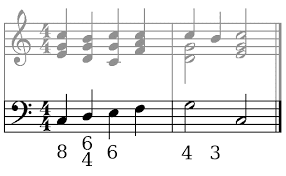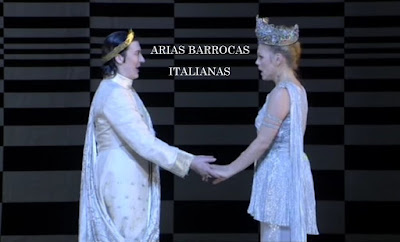0. INTRODUCTION
The Baroque was the artistic period that covered the 17th century and the first half of the 18th century. Musically, we delimit its chronology between two significant dates: the beginning, in the year 1600, with the premiere of the first preserved opera; and the end in 1750 with the death of J. S. Bach, the most famous representative of the musical Baroque.
The people of this era did not go after the ideaI expression of beauty like in the Renaissance; but they were sensitive to passion and fantasy. The baroque art looked for the expression of feelings, the sense of movement and contrasts, and a liking for details and ornamentation.
An interesting overview about this music.
1. BAROQUE MUSIC.
1.1. MUSICAL ELEMENTS
In the Baroque, music has the following characteristics:
· This new composition technique was called accompanied monody. lt represented a shift in the horizontal-melodic conception (counterpoint texture) towards a vertical-chordaI conception (harmonic texture). The prominence of a superior melody implied the appearance of a new low voice, the basso continuo.
· Basso continuo: a low instrumental voice that accompanies the melody and acts as harmonic support.
Click on this page to know more about this new texture:
Click on this page to know more about this new texture:
· Contrast is used as a compositional method. In music, contrast (or stilo concertato) can be established by:
ü forte parts / piano parts.
ü big instrumental ensembles / small instrumental ensembles.
ü instruments of different timbres.
ü vocal parts / instrumental parts.
ü fast movements / slow movements.
· Movement is sought. In music, the feeling of movement is achieved through the following elements:
- a regular an very marked pulsation. The measure is born.
- execution of very fast rhythmic formulas.
- concitato style (playing a very fast rhythm on one note).
· Ancient scales are replaced by the major and minor scales.
ACTIVITY 2
Listen to these musical fragments and identify the movement, the contrast and the new texture.
AIR (SUITE Nº 3, J.S. BACH)
SONATA FOR VIOLIN AND BASSO CONTINUO (J.S. BACH)
1.2 SECULAR VOCAL MUSIC
SONATA FOR VIOLIN AND BASSO CONTINUO (J.S. BACH)
1.2 SECULAR VOCAL MUSIC
- A new genre is born in Italy: opera.
- The opera is a compound vocal form with a narrative nature that makes use of stage performance. lt Is written for orchestra, choirs and soloists, and elaborated in three fundamental parts.
- Overture: instrumental introduction that begins the piece.
- Sung parts: for soloists (main characters) and choirs (supporting characters). We distinguish two types of singing depending on the content of the text:
a) aria style: expressive melodies for more emotional texts.
b) recitative style: declaimed text for passages that require a more agile progress of the action.
- lnterludes: instrumental sections that are inserted in order to join and put together the different parts of the opera.
- The oldest known sheet music of an opera is Monteverdi’s Orfeo’s (1607). But one of the finest examples of the aria style is “Lascia ch’io pianga”.
Rinaldo is an opera by George Frideric Handel composed in 1711. This is the aria "Lascia ch'io pianga".
Si te ha gustado el aria puedes ver más arias barrocas en el siguiente sitio web sobre arias barrocas italianas:
This is the recitative "Dall' ondoso periglio" from the opera "Giulio Cesare" by Händel.
1.3 RELIGIOUS VOCAL MUSIC
· Religious music continued having great importance during the Baroque. The Protestant Church kept the chorale as its most representative form, and the Catholic Church kept cultivating the motet and the mass.
· However, new religious forms appeared like the cantata, the oratorio and the passion (which imitated the grandeur of secular opera).
· Oratorio
It can be regarded as an opera with a religious theme but without stage performance. It is a compound form written for orchestra, choir and soloists, and formed by a sequence of recitatives, arias and choirs.
Since it is not a represented piece, the oratorio introduces the narrator and reinforces the role of the choir, who tell stories based on texts from the Old and New Testaments.
The most representative composers of this form were Giacomo Carissimi (1605-1675) and Georg Friedrich Haendel (1685-1759), whose most famous oratorio is Messiah.
"For Unto Us a Child is Born" is a chorus from the famous oratorio "Messiah" by Händel.
HALLELUJAH (CHORUS FROM "MESSIAH" BY HÄNDEL)
1.4 INSTRUMENTAL MUSIC
· The emancipation of instrumental music that started in the Renaissance, reached its apex during the Baroque and the orchestra played a decisive role as a stable and organized ensemble. The composer was careful with the color of his pieces and detailed the orchestration on the score.
· The Baroque orchestra had got all instrumental families: string, woodwind, brass and percussion. The basis of the Baroque orchestra was bowed string and the basso continuo, usually performed by the harpsichord (although the harp and the organ were also used).
· During the Baroque, many of the large instrumental forms (that marked not only this but all subsequent music) appeared: the suite the sonata and the concerto.
· The concerto is a compound form made up of a sequence of three contrasting movements:
· The concerto is a compound form made up of a sequence of three contrasting movements:
Depending on how the instruments intervene, the concert can be:
a) Concerto grosso: for a group of soloists (concertino) and the rest of the orchestra (tutti). They contrast while alternating the performance of new and fixed parts (ritornello). The most important composers were Arcangelo Corelli (1653-1713), Georg Friedric Haendel and Johann Sebastian Bach.
b) Solo concerto: composed for a single soloist instrument that contrasts in constant dialogue with the orchestra. The most prominent composer was Antonio Vivaldi (1678-1741).
La Folía (Spanish), Follies of Spain (English) or Follia (Italian), is one of the oldest remembered European musical themes, or primary material, generally melodic, of a composition. Many composers have used this theme in their works, such as Jean-Baptiste Lully, Arcangelo Corelli, George Friederic Händel or Antonio Vivaldi, who are considered to highlight this 'later' folia repeating theme in a brilliant way. Listen, please to this "Folia" by A. Vivaldi.
Here we have the Corelli's Folia.
ACTIVITY 5
Part 1. Listen to these four musical fragments and identify the different stylistic elements you hear: concitato style, continuous bass,timbre contrast and dynamic contrast.
Listen to "Spring" from “The four Seasons” by Vivaldi.
Perhaps you will enjoy this "techno" version by Vanessa Mae.
CLASSICAL MUSIC
ACTIVITY 1
Here you have this video about the Classicism in music.
ACTIVITY 2
The Magic Flute (German: Die Zauberflöte, K. 620) is an opera in two acts by Wolfgang Amadeus Mozart for a German libretto by Emanuel Schikaneder. The work is in the form of a Singspiel, a popular form that included both singing and spoken dialogue.
Aria "Der Hölle Rache" ("Queen of the Night's).
The Requiem Mass
The Requiem Mass in D minor (K. 626) by Wolfganf Amadeus Mozart was composed in Vienna in 1791 and left unfinished at the composer's death.
Scene from "Amadeus" film where a dying Mozart dictates the different vocal and instrumental parts of "Confutatis" to Salieri, the Italian composer that worked at the Habsburg court.
"Dies Irae" (from the Sequence of the mass), by Claudio Abbado (conductor).
ACTIVITY 3
ACTIVITY 4
Eine kleine Nachtmusik (Serenade No. 13 for strings in G major), K. 525, is a 1787 composition for a chamber ensemble.
What difference do you notice between the two fragments you hear?.
ACTIVITY 5
A. Identify the genre of these fragemts: string quartet, concert and symphony.
B. This music was adopted as a national anthem by a country. Do you which one?
C. Identify the soloist instrument and the movement of the next fragment.
ACTIVITY 6
Identify the tone of these melodies.




No hay comentarios:
Publicar un comentario